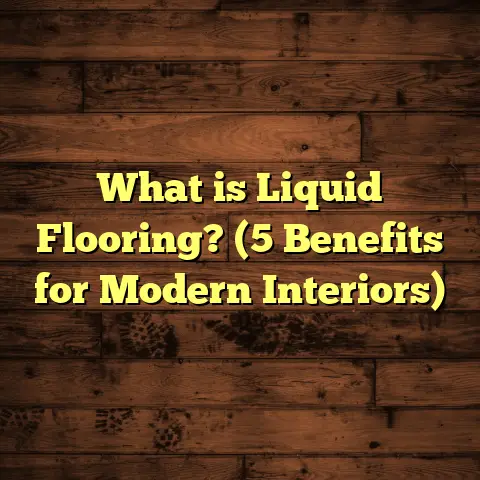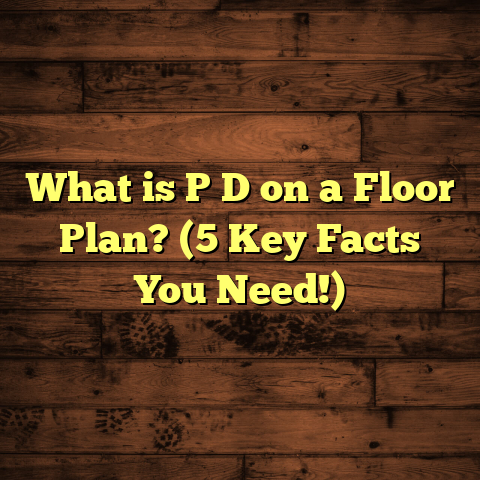What is Floating Floor Installation? (5 Key Benefits Explained)
You know that feeling when you step into a room and your eyes immediately go to the floor? It’s almost like the floor is quietly telling a story — about the house, the people who live there, or even the care and effort put into it. Floors do more than just support your weight; they set the tone for the entire space. Over the years, I’ve installed countless floors of all kinds, but floating floors have consistently stood out for me. They’re practical, stylish, and surprisingly clever in how they’re installed and perform. If you’ve ever wondered what floating floor installation really means and why it’s become such a popular choice, I’m here to share everything I’ve learned.
What is Floating Floor Installation?
Floating floor installation is a method where the flooring material is not nailed or glued to the subfloor beneath. Instead, the planks or tiles are connected to each other and rest on top of an underlayment layer, “floating” over the existing floor. This system relies on a strong locking mechanism (often called click-lock) or adhesive strips between planks to hold everything tightly together.
Unlike traditional hardwood floors that require nails or glue to adhere to the subfloor, floating floors are independent from the surface below. The entire floor essentially acts as one large “floating” platform. Because of this, installers leave expansion gaps around the edges to allow the floor to expand and contract naturally with temperature and humidity changes.
Floating floors are mainly used with laminate flooring, engineered hardwood, and luxury vinyl planks (LVP). Each type has its pros and cons, but the installation method remains consistent across them.
The Underlayment’s Role
One key component of floating floors is the underlayment. It’s a thin layer placed between the subfloor and the floating surface. This underlayment cushions the floor, providing comfort underfoot and reducing noise. It can also act as a moisture barrier when needed, especially in basements or kitchens.
When I started installing floating floors many years ago, I underestimated how much difference a quality underlayment makes. Early on, I used basic foam underlayment in most jobs. Over time, I switched to cork or rubber-based versions for better sound absorption and durability. The clients noticed the difference immediately — less echoing footsteps and a more cushioned feel when walking.
What Makes Floating Floors Different?
I’ve seen some DIYers try to skip this step because they want a “perfect fit,” but trust me, not leaving that expansion space can cause buckling or warping over time.
5 Key Benefits of Floating Floor Installation
Let me walk you through five key reasons why floating floors have become my go-to recommendation for so many projects.
1. Ease and Speed of Installation
If you asked me which benefit stands out most in floating floor installation, it would be speed combined with simplicity. Because these floors don’t require nails or glue to fix them down, installation can be much faster.
In one job I did for a family renovating their living room and kitchen, laying down traditional hardwood would have taken at least three days due to drying time for adhesives and careful nailing. The floating laminate floor we installed took just one day from start to finish — including prep and cleanup.
The click-lock mechanism makes it straightforward: you just snap the planks together like puzzle pieces. Even if you’re not a professional installer, you can usually manage floating floors with some careful measuring, cutting, and patience.
This method is particularly handy for DIY enthusiasts looking to upgrade their homes without calling in expensive labor or waiting around for glue to dry.
2. Cost-Effective Solution
Flooring budgets can spiral quickly if you don’t keep an eye on labor costs and materials. Floating floors tend to be more affordable overall because they reduce labor time significantly.
From my experience using FloorTally — an online tool that helps calculate installation costs based on local rates and material choices — I’ve found that floating floors often save clients between 20% and 35% in total project costs versus traditional hardwood installation.
FloorTally’s detailed inputs let me consider waste factors (extra material needed due to cutting) and local labor rates in real time. This has saved me from underestimating budgets too many times.
For example, if a homeowner wants engineered hardwood but has a tight budget, I can suggest floating engineered wood instead of nailed hardwood. The price difference can be thousands of dollars for a 1,000 square foot area.
3. Versatility Over Various Subfloors
One of my favorite things about floating floors is their flexibility regarding what subfloor they can go over. Unlike nailed hardwood that demands specific subfloor types like plywood or concrete with vapor barriers, floating floors adapt better.
I once helped a client who had old ceramic tile throughout their basement. Instead of tearing out the tile (which would have cost weeks and more money), we installed luxury vinyl plank floating floors right over it after minor leveling work. The result was transformational — modern flooring without the demolition headache.
Floating floors work well over:
- Concrete slabs
- Old vinyl or linoleum
- Ceramic tiles
- Plywood or OSB subfloors
- Even radiant heating systems (with proper product choice)
This adaptability means fewer demolition costs and faster project turnover times.
4. Comfort and Sound Absorption
The underlayment beneath floating floors isn’t just there for moisture protection; it makes a huge difference in comfort and sound control.
I remember installing floating laminate in an apartment building where noise complaints were common due to hard tile floors below. Adding a dense cork underlayment reduced noise transmission by around 40%, according to post-installation feedback from tenants.
Walking on floating floors feels softer than solid hardwood nailed down directly to plywood or concrete because of that cushioning layer. For families with kids or elderly members, this added comfort makes daily life easier on joints.
5. Easy Maintenance and Repair
Damage happens — spilled drinks, dropped tools, pet scratches — but floating floors make repairs less painful.
If a plank gets damaged or stained beyond cleaning, you don’t have to rip up the entire floor or hire professionals for major repairs. You can simply unlock the damaged board and replace it with a new one.
I recall one customer whose dog caused water damage near the kitchen sink area. Instead of spending thousands restoring hardwood throughout their home, they replaced just a few floating vinyl planks themselves in an afternoon.
This patchwork ability saves money and time — two things every homeowner appreciates.
How Floating Floors Compare: Materials and Other Flooring Types
Floating installation isn’t limited to one material; it spans laminate, engineered wood, luxury vinyl plank (LVP), and some hybrid options. Here’s how these materials compare in terms of durability, appearance, cost, and suitability for different rooms:
| Material | Durability | Appearance | Water Resistance | Cost per sq.ft | Ideal Rooms |
|---|---|---|---|---|---|
| Laminate | Moderate | Wood-like | Low (can swell) | $1 – $3 | Living rooms, bedrooms |
| Engineered Wood | Good | Real wood veneer | Moderate | $3 – $7 | Living rooms, dining |
| Luxury Vinyl Plank | Very good | Wood/tile look | High | $2 – $5 | Kitchens, basements |
| Hybrid Flooring | Good | Wood-like | High | $3 – $6 | Multi-use |
Laminate is often chosen for budget projects but lacks true water resistance unless specially treated. Engineered wood brings authentic wood grain but can be sensitive to moisture if installed improperly.
LVP has surged in popularity because it combines durability with water resistance — perfect for kitchens or basements where moisture is an issue.
Personal Stories & Lessons Learned Over Time
Early Mistakes That Taught Me a Lot
When I first started installing floating floors years ago, I jumped into jobs without fully understanding moisture concerns. I installed laminate over concrete slabs without adequate vapor barriers once. A few months later, homeowners reported swelling planks and buckling edges.
That experience taught me the importance of proper subfloor preparation and choosing the right underlayment based on environmental conditions.
A Project That Changed My Perspective
I worked on a large townhouse renovation where we installed engineered wood floating floors throughout all main areas except bathrooms. The client initially worried about durability but was thrilled after two years of heavy use with no visible wear or issues.
She appreciated how easy it was to clean spills compared to her old carpeted floors and loved how quiet the rooms felt thanks to the underlayment.
The Importance of Expansion Gaps
I’ve helped several clients fix problems caused by skipping expansion gaps—floors buckling against walls or doorways causing unsightly bumps or even cracking boards.
Leaving proper gaps of about 1/4 inch around edges isn’t just a suggestion; it’s critical for longevity with any floating floor system.
Data-Backed Insights & Industry Trends
According to industry data from the National Wood Flooring Association (NWFA):
- Floating floor installations have grown by approximately 25% annually over the past five years.
- Laminate flooring accounts for nearly 30% of all residential flooring sales.
- Customer satisfaction surveys show floating floors rank highest for ease of installation and maintenance.
- Environmental impact studies show engineered wood used in floating floors has a significantly lower carbon footprint than traditional solid hardwood due to efficient use of wood veneers.
My own data from client projects confirms these trends: faster installations, fewer callbacks for repairs, and steady demand for affordable yet stylish flooring options.
A Closer Look at Costs: How FloorTally Helps Me Manage Flooring Budgets
Budgeting can be tricky when planning flooring projects. One tool I rely on heavily is FloorTally. It allows me to input project dimensions, choose materials from a wide selection (laminate, vinyl, engineered wood), and customize options like thickness or textures.
FloorTally calculates:
- Material costs based on current local pricing
- Labor estimates reflecting regional wage differences
- Waste factors (usually 5-10%) accounting for cuts and mistakes
- Total project cost with easy-to-understand breakdowns
Using this tool has saved me hours compared to requesting multiple quotes from suppliers or contractors individually. It also helps clients visualize exactly where their money goes—whether into materials, labor, or extra supplies—leading to more informed decisions that fit their budgets perfectly.
Comparing Floating Floors with Other Flooring Solutions
It’s natural to wonder how floating floors compare with other popular flooring types like traditional hardwood, glue-down vinyl, tile, or carpet.
| Flooring Type | Installation Process | Durability | Cost Range | Maintenance | Comfort |
|---|---|---|---|---|---|
| Floating Floors | Click-lock/no glue/brad nails | Good | $2 – $7 per sq.ft | Easy | Soft (with underlayment) |
| Nail-Down Hardwood | Nailed/stapled + finishing | Very durable | $5 – $12 per sq.ft | Moderate | Moderate |
| Glue-Down Vinyl | Adhesive applied on subfloor | Very durable | $3 – $6 per sq.ft | Easy | Firm |
| Tile | Mortar + grout | Extremely durable | $7 – $15 per sq.ft | Moderate | Hard |
| Carpet | Stretch + tack strips | Moderate (wears) | $2 – $7 per sq.ft | High (vacuuming) | Very soft |
Floating floors offer a middle ground: easier installation than hardwood or tile; more durable than carpet; softer underfoot than tile or vinyl glued-down floors.
Final Thoughts: Is Floating Floor Installation Right For You?
If you ask me whether floating flooring is right for your home or project, my answer usually depends on your priorities:
- Do you want fast installation with minimal mess? Floating floors deliver.
- Is budget a concern but you still want a good-looking floor? Floating laminate or vinyl works well.
- Need a versatile option that works over existing floors? Floating style fits perfectly.
- Want easier maintenance with simple repairs? Floating planks let you swap out damaged boards easily.
- Looking for comfort underfoot plus sound dampening? Choose quality underlayment beneath your floating floor.
I’ve seen floating floors transform older homes without major demolition while keeping costs manageable. And in new builds? They speed up move-in times without sacrificing style or durability.
If you want advice tailored to your space, feel free to ask me specific questions about materials or installation tips I’ve picked up from years of hands-on experience.





